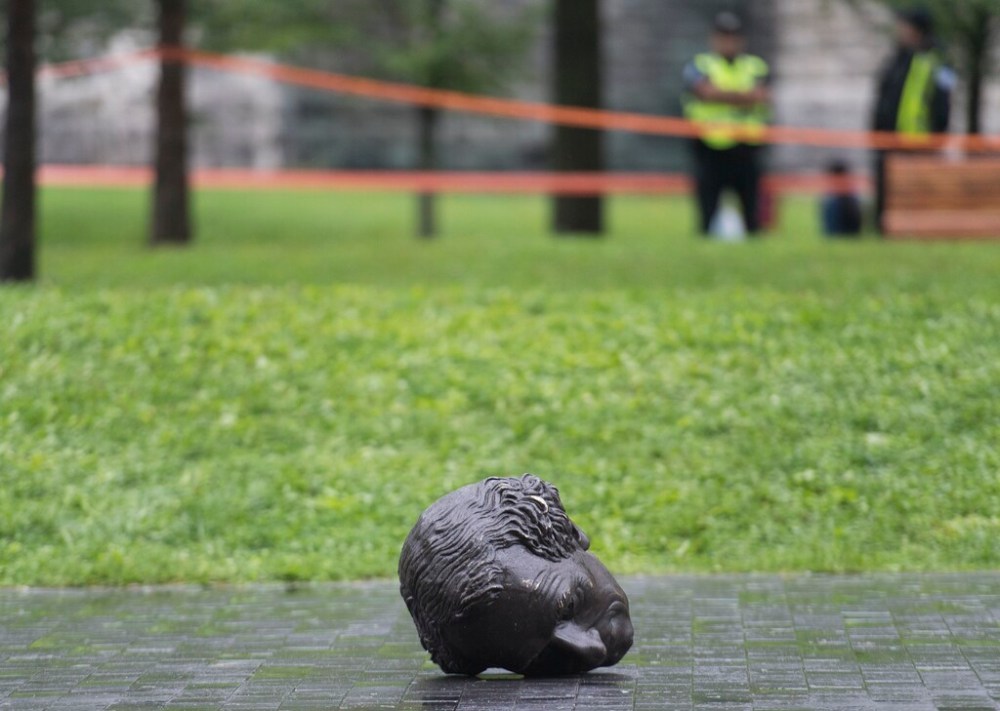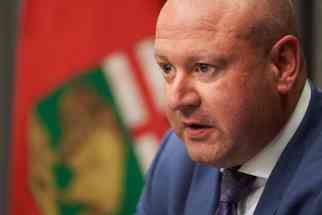Removing statues not the same as erasing history
Read this article for free:
or
Already have an account? Log in here »
To continue reading, please subscribe:
Monthly Digital Subscription
$0 for the first 4 weeks*
- Enjoy unlimited reading on winnipegfreepress.com
- Read the E-Edition, our digital replica newspaper
- Access News Break, our award-winning app
- Play interactive puzzles
*No charge for 4 weeks then price increases to the regular rate of $19.00 plus GST every four weeks. Offer available to new and qualified returning subscribers only. Cancel any time.
Monthly Digital Subscription
$4.75/week*
- Enjoy unlimited reading on winnipegfreepress.com
- Read the E-Edition, our digital replica newspaper
- Access News Break, our award-winning app
- Play interactive puzzles
*Billed as $19 plus GST every four weeks. Cancel any time.
To continue reading, please subscribe:
Add Free Press access to your Brandon Sun subscription for only an additional
$1 for the first 4 weeks*
*Your next subscription payment will increase by $1.00 and you will be charged $16.99 plus GST for four weeks. After four weeks, your payment will increase to $23.99 plus GST every four weeks.
Read unlimited articles for free today:
or
Already have an account? Log in here »
Hey there, time traveller!
This article was published 03/09/2020 (1931 days ago), so information in it may no longer be current.
The outcry over the vandalism of a statue of John A. Macdonald in Montreal was as sad as it was predictable.
Prime Minister Justin Trudeau condemned the protesters that pushed over the metal sculpture and decapitated its head, arguing that acts of vandalism do not advance the causes of social justice and “have no place in a society that abides by the rule of law.”
Trudeau’s comments were accompanied by a torrent of criticism from a chorus of the usual suspects in politics, news media and academia. J.D.M. Stewart, a noted Canadian historian, labelled it a crime against history itself.
.jpg?w=1000)
Stewart wrote in the Globe and Mail that while issues such as systemic racism and reconciliation with Indigenous people are critically important, destroying statues “is not going to advance any of those causes. Nor is it justified by history — although it may make some feel better.”
The debate over historical monuments is complex and, to date, there has been no consensus around solutions. But in the wake of this latest act of vandalism, it’s certainly time for some clarity and sobriety in a debate pockmarked with fallacious reasoning.
First off, attacking the statue of a historical figure is not an attack on history because the statues are not, in and of themselves, essential artifacts. They are one-dimensional tributes to complex historical figures absent of any meaningful context. Those statues do not represent the history of Canada; they represent one, heavily skewed view of our history and as such, have limited value.
Second, although the toppling of statues of deposed leaders is pro forma in coups and revolutions, no one is talking here about expunging the memory of Macdonald. Removing Canada’s first prime minister from the history books would also remove the memory of his more egregious policies, which no one should want.
This is about eliminating a tribute to Macdonald that, objectively speaking, he does not deserve.
The third issue is the allegation that acts of aggression against monuments do not advance the causes of social justice. The fallacy in that statement is pretty evident when you realize the current debate was triggered when protesters defaced and destroyed a statue. In fact, it can be argued that without the occasional act of vandalism or even violence, there can be no real progress on social justice issues.
Any time a protest turns violent or destructive, it has the potential to alienate segments of the population. But peaceful protest is all too easy to ignore. The Black Lives Matter movement, which has been mostly peaceful, is a good example of how destructive, even violent, protests create the impetus for change. It has always been thus when it comes to human or civil rights movements.
And finally, we really need to get to a point where the people who are not affected by historical monuments stop telling the people who are affected to “get over it.”

One of the most potent arguments for removing statues of John A. Macdonald was his treatment of Indigenous people. In particular, his support for the forced starvation and relocation of Indigenous people onto reserves, and the creation of the residential schools system.
Many will rush to point out that in advocating these policies, Macdonald was only demonstrating he was “a man of his time.” And those people are not wrong. But they are wrong to suggest that it’s unthinkable to remove the tributes to — not the memory of — one of the principal authors of those abhorrent policies. Particularly when Indigenous people even today live with the effects of Macdonald’s legacy.
Although the debate here has been thoroughly muddled, there have been moments of clarity elsewhere. Take this year’s decision to remove the controversial “Equestrian Statue” of former U.S. President Theodore Roosevelt from the entrance to the American Museum of Natural History in New York City.
The statue shows a triumphant Roosevelt atop his trusty steed with a Native American on one side, and a Black man on the other, both in subservient posture. After years of protest, the museum agreed to remove the statue, a decision that was ultimately approved by New York City, which owns the building and property.
Not surprisingly, a chorus of howls erupted from the usual suspects, including U.S. President Donald Trump, who labelled it “ridiculous.” But opposition was quieted significantly when Theodore Roosevelt IV, the 77-year-old great-grandson of the 26th president, suggested a new approach was needed.
Historians have, over the years, documented Roosevelt’s support for eugenics theories and, later in his life, forced sterilization of the poor and intellectually disabled. And while the great-grandson obviously felt a need to defend his great-grandfather, he acknowledged the statue had no value in historical terms.
“The world does not need statues, relics of another age, that reflect neither the values of the person they intend to honour nor the values of equality and justice,” he said. “It is time to move the statue and move forward.”

In that one statement, we can see the simple truth of this matter.
We absolutely need to preserve the legacy of our historical figures, both good and bad. But we do not need statues and monuments that, on their own, provide neither a balanced picture of those figures nor a legimate sense of their place in history.
Time to remove the statues and move forward.
dan.lett@freepress.mb.ca

Born and raised in and around Toronto, Dan Lett came to Winnipeg in 1986, less than a year out of journalism school with a lifelong dream to be a newspaper reporter.
Our newsroom depends on a growing audience of readers to power our journalism. If you are not a paid reader, please consider becoming a subscriber.
Our newsroom depends on its audience of readers to power our journalism. Thank you for your support.




.jpg?h=215)

